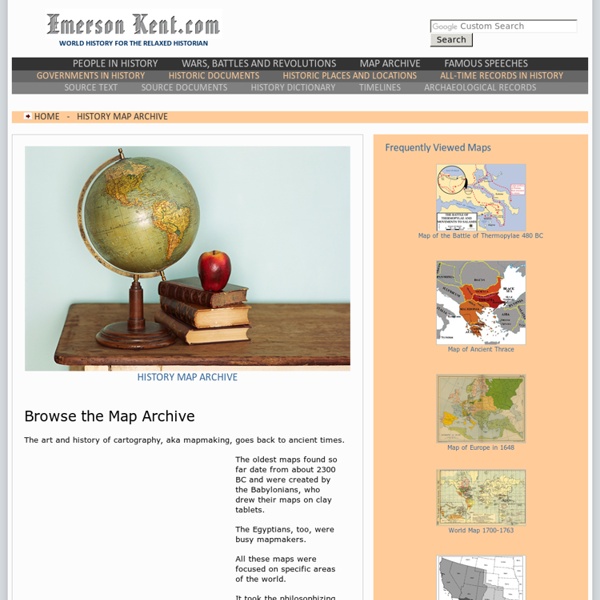Explore georeferenced maps - Map images
© Harris Corp, Earthstar Geographics LLC© 2016 IntermapEarthstar Geographics SIO© 2016 Microsoft Corporation© 2010 NAVTEQ© ANDTerms of Use© 2016 DigitalGlobeImage courtesy of NASAImage courtesy of USGS© Getmapping plc© 2016 GeoEye© 2016 Pasco© GeoContent / (p) IntergraphImage courtesy of the IndianaMapImage courtesy of the Nevada State Mapping Advisory Committee© 2016 InterAtlas© 2016 Eurosense© 2016 IGP© 2016 IGN© Province of British Columbia© 2016 Blom© 2016 Aerials ExpressImage courtesy of LAR-IACImage courtesy of ImagePatch.comState of Michigan© 2012 DigitalGlobe© 2010 MapData Sciences Pty Ltd, PSMA© 2010 Zenrin
Miklian Antiquarian Maps
History of Europe
Euratlas Periodis Web shows the history of Europe through a sequence of 21 historical maps, every map depicting the political situation at the end of each century. Here, on the left, are 21 mini-maps giving access to 21 full maps and to 84 quarters of maps with more detailed views of the states, provinces and main cities.Moreover, each map offers a historical gazetteer. Thus you can highlight in red each sovereign state and in green each dependent entity. See the Map Legend for more details. Navigation through the atlas is easy: on the left side of the pages, you simply need to choose a century for temporal navigation. Periodis is a historical atlas of a new kind. History by Periods History is a continuous string of events among which prominent facts sometimes emerge: wars, conquests, revolutions etc. Names Names of entities mentioned in the Periodis Historical Atlas are those officially used at the considered time.
Timelines of History, Today in History, World History
Boston Massacre Historical Society
Victorian London in Incredible Detail
Here’s a real treat. The National Library of Scotland’s Map Department, supported by David Rumsey, have taken some very high-resolution scans of the Ordnance Survey 1:1056 (that’s 60 inches to the mile!) set of 500+ maps of London issued between 1893 and 1896 and, crucially, reorientated and stitched them together, so that they can be presented seamlessly (using OpenLayers) on top of a “standard” Google web map or OpenStreetMap, with the base map acting as a modern context. The detail in these maps is breathtaking. In the above extract (direct link) of the eastern end of Fleet Street, you can see each individual alleyway. Much of London has of course changed in the intervening 120 years. Here are the individual towers, rooms and staircases, in part of the Tower of London: Here’s University College London’s main building – with internal stairways, rooms and even wall thicknesses visible. While many areas are largely unchanged from 120 years ago, some places are distinctively different.
1900 Map Collection
the Centennia Historical Atlas -- Europe and the Middle East 1000AD to the Present, software for Windows and Mac OSX
Lower price starting May 15, 2013: A single-user license is now priced at $59.00 with discounts for more licenses. Recent Additions and Changes:Single-user access code: lower priceNew Windows edition (Windows 8, 7, Vista, XP compatible)Macintosh OSX edition (Leopard, Snow Leopard compatible)Added review by Prof. Charles IngraoEU focus (for example, see the EU in 2008)Color schemesRead about the creator of CentenniaCentennia Software's home port is now Conanicut Island USA CENTENNIA is a map-based guide to the history of Europe and the Middle East from the beginning of the 11th century to the present. It is a dynamic, animated historical atlas including over 9,000 border changes. The map controls evolve the map forward or backward in time bringing the static map to life. From Kevin Kelly's review of Centennia which was published in the Whole Earth Catalog: "As a kid I dreamed of maps that would move; I got what I wanted in Centennia. Professor Charles Ingrao, Purdue University wrote:
English Dissenters: Ranters
Ranters embraced the general concept of the "indwelling spirit", a form of religious perfection. Whatever was done in the Spirit was considered justifiable to a Ranter. Man was therefore free of Sin and the Laws of Moses. As with others nonconformists during this period, the very nature of religion was being called into question. Outward forms of religion were rejected. Contemporaries of the period often compared the Ranters and the Quakers as being cut from the same bolt of cloth. Ranters and some Quakers of the period were known to cavort in the all together. Nudity in all its forms was considered a major societal taboo during the period. The Adamites of the early 1640's were often stereotyped in the nude. , [fl. 1650-1652] was a prominent Ranter leader. , or better known as was also a prominent radical of the period. , a companion of Clarkson, and who like Clarkson was imprisoned for acts against the public welfare, and for his own radical writings. Primary Sources [Anon.] [Anon.]
Miscellaneous 2
The Perfect 22-Foot Map for Your Ancient Roman Road Trip
A close-up of the Tabula Peutingeriana. (Photo: Public Domain/WikiCommons) If you’re planning a road trip in ancient Rome, you'll need two things: a time machine, and the Tabula Peutingeriana. Also known as the “Peutinger Map,” the Tabula illustrates the complex road networks of the Roman Empire. This segment includes the boot of Italy, the Mediterranean Sea, and what's now southern Tunisia and Tripolitania. Given the size of the Roman Empire at its height, your ancient road trip could start in Europe and have stops in North Africa, the Middle East, and parts of Asia. If Atlas Obscura existed in ancient Rome, we'd probably recommend that you check out the mountain views by the Tarento resupply station or the excellent foot courier treatment along the Coriello coast. The full expanse of map, all 6.75 meters of it. The public roads, or cursus publicus, marked on the Tabula Peutingeriana were built in the first century under Emperor Augustus to improve imperial communication.



